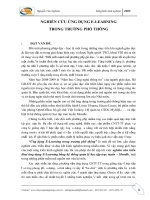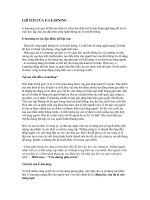Learning Thireo
Bạn đang xem bản rút gọn của tài liệu. Xem và tải ngay bản đầy đủ của tài liệu tại đây (190.61 KB, 15 trang )
LLEARNINGEARNING T
THEORIESHEORIES
by Wikibooks contributors
From Wikibooks,
1BEHAVIORALIST
Introduction
Behaviorism, as a learning theory, can be traced back to Aristotle, whose essay “Memory”
focused on association being made between events such as lightning and thunder. Other
philosophers that followed Aristotle’s thoughts are Hobbs (1650), Hume (1740), Brown
(1820), Bain (1855) and Ebbinghause (1885) (Black, 1995). Pavlov, Watson, Thorndike and
Skinner later developed the theory in more detail. Watson is the theorist credited with coining
the term "behaviorism".
Behaviorism as a learning theory
The school of adult learning theory that adopted these principles has become known as the
school of behaviorism, which saw learning as a straightforward process of response to stimuli.
The provision of a reward or reinforcement is believed to strengthen the response and therefore
result in changes in behavior – the test, according to this school of thought, is as to whether
learning had occurred. Spillane (2002) states, “the behaviorist perspective, associated with B.
F. Skinner, holds that the mind at work cannot be observed, tested, or understood; thus,
behaviorists are concerned with actions (behavior) as the sites of knowing, teaching, and
learning” (p. 380). One of the keys to effective teaching is discovering the best consequence to
shape the behavior. Consequences can be positive or negative – punishing or rewarding.
“Extinction” occurs when there is no consequence at all – for example if you knock at the door
and no one answers, pretty soon you simply stop knocking (Zemke, 2002).
The seminal work of Pavlov demonstrated that the application of neutral stimuli could be used
to elicit a response from animals. From these initial studies other psychologists such as John
Watson and BF Skinner demonstrated that these principles could be applied to humans with the
addition of a reinforcement element (Cheetham & Chivers, 2001). They demonstrated that
responses related to more complex behavior could be achieved, which they termed “operant
responses.” One of the assumptions of many behaviorists is that free will is illusory, and that
all behavior is determined by a combination of forces. These forces comprise genetic factors as
well as the environment either through association or reinforcement.
This theory has latterly been criticized as overly simplistic. Nevertheless, its influence can be
seen in educators’ insistence that feedback is critical to learning. The stimulus-response method
is used frequently in adult learning situations in which the students must learn a time sensitive
response to a stimulus. Aircraft emergency procedures, for example, are divided into two parts.
The first, the time sensitive portion, must be immediately performed by rote memory upon
recognition of a stimulus – a warning light, horn, buzzer, bell, or the like. These procedures are
taught and reinforced with rote drills and successfully passing the tests is the reinforcement.
The second portion of the procedure, which may be viewed as diagnostic action is performed
with mandatory reference to checklists and other reference material and depends on what may
be viewed as higher level learning and understanding of aircraft systems and performance
characteristics.
Behaviorist Theory maintains a focus on the change in observable behaviors as the
manifestations of learning. The theory emphasizes changes in behaviors due to the
influence and control of the external environment, rather than the internal thought
process of the subject (Merriam & Caffarella, 1999). Simply put, people will learn desired
behaviors due to stimuli from their external environment that recognize and reinforce the
behavior in a positive manner. Undesired behaviors can be controlled or eliminated by an
absence of attention to or recognition of such.
Behaviorism is comprised of several individual theories that have a common theme functioning
within them. This common theme is found in the ways the theorists define what learning is, and
how it is accomplished. The common assumptions of these theorists are threefold, as explained
by Merriam and Caffarella (1999). The first common assumption is the emphasis on observable
behavior rather than internal thought processes create learning. Second, ultimately it is the
environment that creates learning and it determines what is learned, not the individual learner.
Lastly it is the ability to understand the overall process, and the ability to repeat or reinforce
that process that is a common thread (Merriam and Caffarella, 1999). This theory is most
commonly seen in adult learning when organizations take repeatable training steps and
systematize them into manageable tasks.
The hypothesis behind behavioralist learning theories is that all learning occurs when behavior
is influenced and changed by external factors (Merriam & Caffarella, 1999). Behavioralism
disregards any notion that there may be an internal component to man’s learning. Grippin and
Peters (1984) emphasize that “contiguity…and reinforcement are central to explaining the
learning process” (Merriam & Caffarella, 1999, p. 251) in regard to an individual’s subjugation
to external stimulus as a determinant of response (i.e., behavior). Contiguity is understood as
the timing of events that is necessary to bring about behavioral change, while reinforcement
refers to the probability that repeated positive or negative events will produce an anticipated
change in behavior (Merriam & Caffarella, 1999).
Behavioral theory and training is a key component of animal training and skill training in
humans. Teaching animals to sit for a kibble is very similar to clapping and hugging your child
for their first steps or bike ride. Slot machines are based on intermittent reinforcement, which
in turn leads gamblers to put more quarters in the machine to be reinforced by the ching ching
of winning. As students, we are reinforced by the 100 points or A we receive on the test or
paper, or by the removal of the F on the grade card. Source [1]
Behavioral theories have also been studied and applied in organizational leadership. Dating
back to the 1940's, studies were conducted at Ohio State University (OSU) and the University
of Michigan (UM) (Robbins 1998). What the researchers found in the OSU and UM studies
can be classified into two categories: relationships and results. In the OSU studies, researchers
compiled behaviors into two dimensions: initiating structure (results) and consideration
(relationships). UM researchers compiled their leader behavior under two similar dimensions:
employee oriented and production oriented. From this research, Blake and Mouton developed
the Managerial Grid, later to be called the Leadership Grid. This grid assists leaders in
assessing possible outcomes to their behavior within an organization. Robbins states, "The grid
does not show results produced but, rather, the dominating factors in a leader's thinking in
regard to getting results" (p. 351). Behavioral leading and learning is based on organizational
and cultural conditioning. This can be observed in the tough-handed, "hatchet wielding"
approach of Jack Welch and in the benevolent "lend-a-hand" approach of Herb Kelleher.
Behavioral theories within leadership have had "modest success in identifying consistent
relationships between patterns of leadership behavior and group performance. What seems to
be missing is consideration of the situational factors that influence success or failure" (p. 353).
Simplistic or fundamental?
Some might view this theory as being a very elementary learning process. It suggests, by and
large, that any learning is result oriented, and, therefore, learned by repetitive actions based on
punishments or rewards. Merriam and Caffarella (1999) refer to Thorndike's work which used
animals in controlled experiments to determine learning behavior based on the stimilus
presented. This process, while presenting a possible outcome for comparison, is unrealistic
when compared to the intelligence capabilities of humans. It could be argued that this theory
tends to diminish the possibilities in human learning. In some circumstances, however, this
method of learning is necessary; particularly when dealing with individuals with lower
reasoning abilities or lower intelligence.
Pattison (1999) suggested that American adult education’s roots in liberal arts education and
then progressive education quoting (Elias & Merriam, 1995, p. 205). This progressive
education focused upon the broad populace, not just social elites which liberal education
intended to do according to Pattison. This progressive education began taking hold in the
1920’s in public education settings. Into this social setting Behaviorism came. Pattison suggest
that early behaviorists like John Watson focused on job skills and behavior adaptation that
would “secure the survival of humans, societies, and individuals.” Behaviorism coupled with
progressive education would help “control human behavior and viewed education as a tool for
bringing about societal change” (p. 6).
Behaviorist theory presents learning in short manageable blocks that build on previously
learned behaviors. Kearsley (1994) identified three fundamental principles common in
behaviorist learning:
1.Positive reinforcement of the desired behavior will most likely prompt the same behavior.
2.Learning should be presented in small manageable blocks.
3.Stimulus generalization of learning can produce secondary conditioning.
The goal of this learning method is to transform the learner’s behavior to a “desired” behavior.
The learner is rewarded often for exhibiting the desired behavior when they accomplish a
learning block. This method is heavily used in the federal government to quickly train
employees on the latest policies and procedures (i.e. government credit card use, anti-terrorism,
and sexual harassment). In addition, this method is ideal for short lessons (no more than 20
minutes) which can be accomplished over the internet from the employee's desktop computer.
Within the 20 minute timeframe, the employee will normally retain key points of the lesson.
However, when the lesson goes beyond the 20 minute window, there is a potential for the
employee to lose focus and hurry through it in order to fulfill the requirement and get back to
work. As a result, the employee retains very little and the organization has very little success in
achieving the desired behavior.
While it is true behaviorist theories can be simplistic in their concept, their application to the
human has allowed for much to be discovered about learning, memory and even neuroscience.
Since the late 1800's, psychologists using behavioral principles have established hundreds of
tests to identify both how learning and memory occur in varying complexities of brain
structures. Across many species, for example, it has been shown that when the reinforcing
agent is "painless" then learning occurs in the cerebellum. However if there is an emotional
connection (particularly negative such as fear) to the reinforcer then learning and memory
occur in the amygdala (Kolb & Whishaw, 2005)
Training of individuals centers on the concept that all learning is the result of the environment
acting upon behaviors. The environment of an individual reinforces behaviors either positively
or negatively and all of learning takes place through environmental influences. Adult learning
can be seen strictly through this focus, but a more centrist approach is neobehaviorism.
Neobehaviorism suggests that not only does the environment reinforce behavior, but there is an
interaction between the individual and the environment. This is an important concept as it
relates to adult learning because of the relative importance of choices to motivation in the
learning process (Ross, 2002).
While Behaviorist Theory was founded in the early decades of the twentieth century, there still
exist many examples of support for the theory. It is not uncommon for organizations to
articulate the desired behaviors they expect will lead to positive business results. Organizations
then reinforce those behaviors through performance management and by adjusting the
environment to reward or recognize the desired behaviors. For example, many companies
measure employee performance on two dimensions: business results and desired behaviors. As
well, organizations encourage, through recognition, such positive behaviors as perfect
attendance, employee suggestions for improvements, raising quality issues that would
adversely impact a customer, and good safety behaviors.
Various approaches to promote behavioralist theory in Organizational Learning are many times
predicated on the belief that organizational members prefer, if not altogether require specific
standard operational procedures (SOP). In other words, creative problem solving does not
come naturally with most group members. Following such rationale, Foil and Lyle (1985) note
that this theory is counter to cognitive reasoning which would look at what is happening
environmentally and determine whether SOP is the most appropriate response to each various
event.
Case studies & workplace examples
Attendance point system
One example of behavioral learning in the workplace is through an attendance point system.
Often times, this type of system offers both positive and negative reinforcement. For example,
most companies using a point system have a written policy stating that employees may accrue a
maximum amount of points during a 12-month revolving period. An employee is then given a
partial point, or more, towards an accrual of the maximum allowable anytime there is an
infraction of the policy – especially an attendance infraction. The negative reinforcement is the
notification of accrued points and disciplinary action taken per level of point accrual –
sometimes culminating in termination of the employee. Positive reinforcement can occur when
there is periodic recognition of employees with “perfect” attendance or zero points. There is
one possible fallacy in the system, however. It occurs when an employee appears to be no
longer controlled by the point system, but rather controls the system by knowing just how
many points can be accrued without soliciting discipline. It is in this last scenario that one
understands why most theorists have come to believe that learning is not solely comprised of
external influence but that it also includes an internal component as well.
Continental Airlines
Continental Airlines applied this behavioral learning approach in a very successful
effort to reduce absenteeism and increase performance during the turnaround
engineered by Gordon Bethune. Taking over after the disastrous reign of Frank
Lorenzo when employee moral and commitment declined to the point that
Continental employees would frequently remove the company logos from their
uniforms, Bethune realized that rewarding employees for what was really important
would drive important behavioral changes. Bethune realized that what was important was
rebuilding passenger confidence and preference by providing service that met customer needs.
To this end, the company implemented quarterly bonuses for all employees based on achieving
targeted levels of performance in the FAA quarterly ratings of airlines based on lost baggage
claims, on time departures, and customer complaints. In addition, employees with perfect
attendance each quarter were entered were entered into drawings for Ford Explorers. Both
programs resulted in marked changes in behavior and contributed to the turnaround from the
edge of bankruptcy. (Bethune and Thuler, 1998)
Time clock
Another example that is elementary yet worth mentioning is The Salvation Army, Canton
Corps' use of a time clock. The initial purpose of the clock in that environment was uncertain.
We found that most people who use the time clock were not using it as intended. Many did not
remember to clock in or out, or they would not use the clock at all. Not until pressure was
exerted on each employee by ruling that they would not get paid if their cards were not
adequately punched, did employees begin to use the time clock appropriately. In a few short
weeks of reminders and a few short paychecks, the time clock was being used properly.
2CONSTRUCTIVIST
Introduction
Constructivism is a new learning theory that attempts to explain how adult learners learn by
constructing knowledge for themselves. This section will explore the constructivist learning
theory by defining constructivism, providing varying views of constructivism, and illustrating
how constructivism relates to independent learning and higher education.
Constructivism defined
Constructivism is a synthesis of multiple theories diffused into one form. It is the assimilation
of both behaviorialist and cognitive ideals. The “constructivist stance maintains that learning is
a process of constructing meaning; it is how people make sense of their experience” (Merriam
and Caffarella, 1999, p. 260). This is a combination effect of using a person’s cognitive
abilities and insight to understand their environment. This coincides especially well with
current adult learning theory. This concept is easily translated into a self-directed learning
style, where the individual has the ability to take in all the information and the environment of
a problem and learn.
View points
Although varying constructivist theories exist, there is agreement between the theories “that
learning is a process of constructing meaning; it is how people make sense of their experience”
(Merriam & Caffaerall, 1999, p. 261). Two viewpoints of constructivist theories exist. They
include the individual constructivist view and the social constructivist view. The individualist
constructivist view understands learning to be an intrinsically personal process whereby
“meaning is made by the individual and is dependent upon the individual’s previous and
current knowledge structure” (p. 261) and as a result can be considered an “internal cognitive
activity” (p. 262). The social constructivist view, however, premises that learning is
constructed through social interaction and discourse and is considered, according to Drivers
and others (1994), to be a process in which meaning is made dialogically (Merriam &
Caffaerall, 1999).
Constructivist theory and independent learning
When applying this theory to independent learning, it is essential to understand that we need to
consider the cultural environment in which this learning takes place. Isolated learning is an
oxymoron. Merriam and Caffarella (1999) suggest that adult learning, while self-directed, must
have input from outside influences. That may take the form of investigation, social interaction,
or more formal learning environments.
The constructivistic learning approach involves educators building school curriculum
around the experience of their students. Constructivists believe learner-centric
instructional classroom methods will strengthen the commitment and involvement of
self-motivated learners because of their high level of interaction. Today, there is a
trend for incorporating technology into the classrooms to support instructional learning
methods. Yet, recent studies have revealed technology is not effectively integrated with the
concepts of constructivism (Hare et al, 2005).
Constructivist theory's (J. Bruner) main theme is that learning is a process in which the learner
is able to build on present and previous information. The student is able to take information,
create ideas and make choices by utilizing a thought process. The trainer should encourage the
student to develop the skills to find out principles on their own. There should be on-going
dialog between the student and the trainer. The trainer is responsible for making sure the
information is in a format the student can comprehend. The key is to assure the course builds
on what has already been learned.
3POST-MODERN
Overview
Postmodernism, by the nature of the movement itself, is not easy to define. To understand
postmodernism in the context of adult learning, it may be beneficial to first understand that the
postmodern movement is much larger than adult learning. It is inclusive of a wide variety of
disciplines and areas of study including art, architecture, music, film, literature, sociology,
communications, fashion, technology, and education (Klages, 2003). Because postmodernism
is as much a philosophical movement as it is a learning theory, it is impossible to discuss the
movement without also discussing the underlying philosophy and ubiquity of the postmodern
movement.
Post-modernism differs from most approaches to learning in two fundamental ways. The first is
that rationality and logic are not important to attaining knowledge. The second is that
knowledge can be contradictory. Because of the contextual nature of knowledge, individuals
can hold two completely incongruent views of one subject at the same time (Kilgore, 2001).
Post-modernism relates to post-industrialism. The industrial era came about as a result of
Newtonian thinking – an era wherein thought and processes were considered in mechanistic
terms of efficiency and effectiveness and understood scientifically through the processes of
reductionism (the simplification of the complex into understandable, and at times
oversimplistic terms). The learning gleaned from the industrial (modern) era laid a foundation
for the world to add new knowledge through a new era - what is now termed as the “post-
modern” era. Presently, several post-modern theories exist, but at the core of each of these
theories is the basic concept that what was once only understood within the context of









